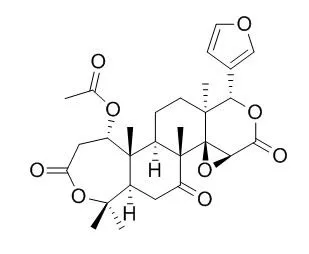| Kinase Assay: |
| Vitam Horm. 2013;91:425-39. | | Nomilin as an anti-obesity and anti-hyperglycemic agent.[Pubmed: 23374727] |
METHODS AND RESULTS:
Recent scientific findings support the notion that bile acids, which are cholesterol catabolites, are bioactive signaling molecules that function as ligands for the farnesoid X receptor or a G-protein-coupled receptor, TGR5. Through these receptors, bile acids can maintain not only bile acid homeostasis but also lipid and carbohydrate homeostasis. An intriguing finding regarding the role of TGR5 in energy metabolism and glucose homeostasis suggests a potential approach to combat obesity and insulin resistance by targeting this receptor to increase thermogenesis and incretin secretion.
CONCLUSIONS:
In this review, I have summarized the latest findings related to TGR5 agonists, in particular, a citrus limonoid, Nomilin, and the roles of these agonists in energy metabolism and glucose homeostasis. | | Eur J Pharmacol. 2011 Oct 15;668(3):450-8. | | Nomilin inhibits tumor-specific angiogenesis by downregulating VEGF, NO and proinflammatory cytokine profile and also by inhibiting the activation of MMP-2 and MMP-9.[Pubmed: 21839074] | Angiogenesis is a crucial step in the growth and metastasis of cancers. Antiangiogenic activity of Nomilin was studied using in vivo as well as in vitro models.
METHODS AND RESULTS:
Nomilin significantly inhibited tumor directed capillary formation. Serum proinflammatory cytokines such as IL-1β, IL-6, TNF-α and GM-CSF and also serum NO levels were significantly reduced by the treatment of Nomilin. Administration of Nomilin significantly reduced the serum level of VEGF, a proangiogenic factor and increased the antiangiogenic factors IL-2 and TIMP-1. In vitro studies using rat aortic ring assay showed that administration of Nomilin at non-toxic concentrations significantly inhibited microvessel sprouting. Studies using human umbilical vein endothelial cells clearly demonstrated that administration of Nomilin significantly retarded endothelial cell proliferation, migration, invasion and tube formation.
CONCLUSIONS:
These data clearly demonstrate the antiangiogenic potential of Nomilin by downregulating the activation of MMPs, production of VEGF, NO and proinflammatory cytokines as well as upregulating IL-2 and TIMP. | | Integr Cancer Ther. 2012 Mar;11(1):48-60. | | Nomilin inhibits metastasis via induction of apoptosis and regulates the activation of transcription factors and the cytokine profile in B16F-10 cells.[Pubmed: 21665879] | Nomilin is a triterpenoid present in common edible citrus fruits with putative anticancer properties.
METHODS AND RESULTS:
In this study, the authors investigated the antimetastatic potential of Nomilin and its possible mechanism of action. Metastasis was induced in C57BL/6 mice through the lateral tail vein using highly metastatic B16F-10 melanoma cells. Administration of Nomilin inhibited tumor nodule formation in the lungs (68%) and markedly increased the survival rate of the metastatic tumor-bearing animals. These results correlated with the biochemical parameters and histopathological analysis. Nomilin showed an inhibition of tumor cell invasion and activation of matrix metalloproteinases. Treatment with Nomilin induced apoptotic response, characterized by an increase in the sub-G1 fraction of cells with chromatin condensation and membrane blebbing, a typical ladder of DNA fragmentation, and detection of apoptotic cells by TUNEL assay. Nomilin treatment also exhibited a downregulated Bcl-2 and cyclin-D1 expression and upregulated p53, Bax, caspase-9, caspase-3, p21, and p27 gene expression in B16F-10 cells. Proinflammatory cytokine production and gene expression were found to be downregulated in Nomilin-treated cells.
CONCLUSIONS:
The study also reveals that Nomilin could inhibit the activation and nuclear translocation of antiapoptotic transcription factors such as nuclear factor (NF)-κB, CREB, and ATF-2 in B16F-10 cells. |
|
| Cell Research: |
| Phytomedicine. 2003;10(6-7):483-9. | | Effect of naturally occurring triterpenoids glycyrrhizic acid, ursolic acid, oleanolic acid and nomilin on the immune system.[Pubmed: 13678231 ] |
METHODS AND RESULTS:
The effect of naturally occurring triterpenoid compounds such as glycyrrhizic acid, ursolic acid, oleanolic acid, and Nomilin on the immune system was studied using Balb/c mice. Intraperitoneal treatments with 5 doses of these terpenoid compounds were found to enhance the total white blood cells (WBC) count. In ursolic acid, oleanolic acid and Nomilin treated animals the maximum total WBC count was observed on the 6th day, while in glycyrrhizic acid treated animals it was observed only on the 9th day after the drug treatment. In ursolic acid, oleanolic acid and Nomilin treated animals the percentage of increase in the total WBC count was to 91.48 +/- 4.6%, 135.75 +/- 6.4% and 117.33 +/- 17.9% respectively. In the glycyrrhizic acid treated animals the total WBC count was increased to 114.9 +/- 18%. Bone marrow cellularity and alpha-esterase positive cells were also enhanced by the treatment with these terpenoids. Treatment with various triterpenoids along with antigen produced an enhancement in the specific antibody titre and the number of plaque forming cells (PFC) in the spleen. Triterpenoids remarkably inhibited delayed type hypersensitivity reaction (DTH).
CONCLUSIONS:
These results indicate the immunomodulatory activity of naturally occurring triterpenoids such as glycyrrhizic acid, ursolic acid, oleanolic acid and Nomilin. |
|






 Cell. 2018 Jan 11;172(1-2):249-261.e12. doi: 10.1016/j.cell.2017.12.019.IF=36.216(2019)
Cell. 2018 Jan 11;172(1-2):249-261.e12. doi: 10.1016/j.cell.2017.12.019.IF=36.216(2019) Cell Metab. 2020 Mar 3;31(3):534-548.e5. doi: 10.1016/j.cmet.2020.01.002.IF=22.415(2019)
Cell Metab. 2020 Mar 3;31(3):534-548.e5. doi: 10.1016/j.cmet.2020.01.002.IF=22.415(2019) Mol Cell. 2017 Nov 16;68(4):673-685.e6. doi: 10.1016/j.molcel.2017.10.022.IF=14.548(2019)
Mol Cell. 2017 Nov 16;68(4):673-685.e6. doi: 10.1016/j.molcel.2017.10.022.IF=14.548(2019)